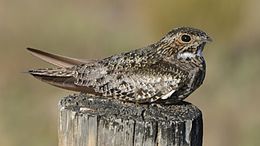Chordeiles minor
| Common nighthawk | |
|---|---|
 |
|
| Scientific classification | |
| Kingdom: | Animalia |
| Phylum: | Chordata |
| Class: | Aves |
| Order: | Caprimulgiformes |
| Family: | Caprimulgidae |
| Genus: | Chordeiles |
| Species: | C. minor |
| Binomial name | |
|
Chordeiles minor (J. R. Forster, 1771) |
|
| Subspecies | |
|
See text. |
|
| Synonyms | |
|
Caprimulgus minor |
|
See text.
Caprimulgus minor
Chordeiles virginianus
The common nighthawk (Chordeiles minor) is a medium-sized crepuscular or nocturnal bird within the nightjar family, whose presence and identity are best revealed by its vocalization. Typically dark (grey, black and brown), displaying cryptic colouration and intricate patterns, this bird is difficult to spot with the naked eye during the day. Once aerial, with its buoyant but erratic flight, this bird is most conspicuous. The most remarkable feature of this aerial insectivore is its small beak that belies the massiveness of its mouth. Some claim appearance similarities to owls. With its horizontal stance and short legs, the common nighthawk does not travel frequently on the ground, instead preferring to perch horizontally, parallel to branches, on posts, on the ground or on a roof. The males of this species may roost together but the bird is primarily solitary. The common nighthawk shows variability in territory size.
This caprimulguid has a large, flattened head with large eyes; facially it lacks rictal bristles. The common nighthawk has long slender wings that at rest extend beyond a notched tail. There is noticeable barring on the sides and abdomen, also white wing-patches.
The common nighthawk measures 22 to 25 cm (8.7 to 9.8 in) long, displays a wing span of 51 to 61 cm (20 to 24 in) weighs 55 to 98 g (1.9 to 3.5 oz), and has a life span of 4 to 5 years.
The genus name Chordeiles is from Ancient Greek khoreia, a dance with music, and deile, "evening". The specific minor is Latin for "smaller".
The term "nighthawk", first recorded in the King James Version of 1611, was originally a local name in England for the European nightjar. Its use in the Americas to refers to members of the genus Chordeiles and related genera was first recorded in 1778.
The common nighthawk is sometimes called a "bull-bat", due to its perceived "bat-like" flight, and the "bull-like" boom made by its wings as it pulls from a dive. Another name is "goatsucker" (the Latin for goatsucker is Caprimulgus), from an archaic, erroneous idea that the birds would fly into barns at night and suck dry the teats of goats.
...
Wikipedia

